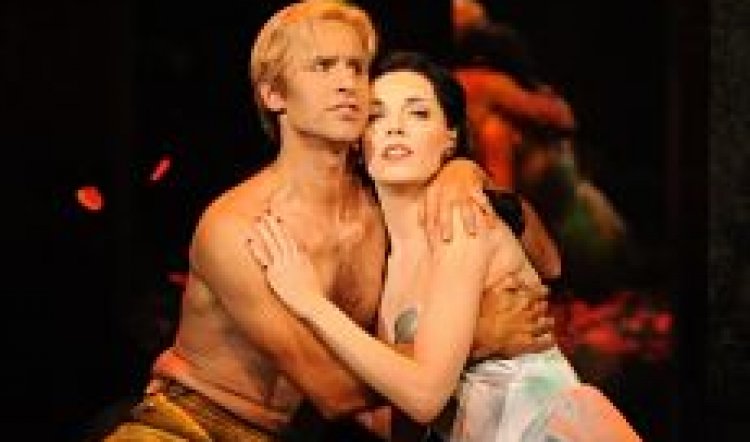
Orlando
Orlando, Opera Australia, Sydney Opera House, August 18-September 11, 2008; phone (02) 9250 7111 or www.sydneyoperahouse.com
THE BAROQUE – in opera or otherwise – is not everyone’s flute of champagne. Nevertheless, there seems to be a surge in its fashionablity around the world these days and that means, if we’re lucky, productions of the less well known pieces may pop up. Orlando is one such and a much anticipated event in the Opera Australia calendar.
First of all: the singers and the orchestra (with continuo of Tommie Anderson on theorbo, Zoltan Szabo, cello and Benjamin Bayl, harpsichord) under the baton of Paul Goodwin are truly excellent and a delight to listen to. New visitor to Australia, the Italian contralto Sonia Prina, is spectacular in the trouser role of Orlando. Her vocal agility in the virtuosic embellishments is reminiscent in power and accuracy of Cecilia Bartoli (happily without CB’s sometimes unfortunate mechanical precision). Prina also gives good swagger and is more boyish than butch as the returning military man whose jealousy will bring all – including his own sanity – undone.
As Orlando’s two-timing fiancee Angelica, Rachelle Durkin is also vocally adept as well as managing the tricky combination of regal and flirtatious while falling for the wounded enemy soldier Medoro. As the limping beau Tobias Cole is gorgeous in Prince Valiant blond wig, which detracts not a bit from his six-pack and sublime warm male soprano.
For Wednesday night’s performance Amy Wilkinson (just out of Don Giovanni) stepped in to the crucial role of Dorinda the shepherdess – replacing the ailing Hye Seoung Kwon – and was not only heroic, but also very good in her own right as actor and singer. Wilkinson is a class act.
Last but not least is Richard Alexander as Zorastro, an aged sage and observer of human foibles. He too handles the demanding vocal style with ease and grace and is an anchoring presence amid the flights of fancy of plot and production.
The production. In common with much baroque entertainment, the plot of Orlando is either splendidly overwrought or ridiculous, depending on your point of view. On the other hand it could be said to offer a few hints and glimpses of signs and symbols without ever spelling them out. It was a method that stood Shakespeare in good stead and kept him out of trouble with patrons while giving audiences something to whisper about afterwards.
The plot(s) of Orlando could be seen to offer all of the above, but you’d have to be a master codebreaker or on strong substances to figure it out from this bizarre production. Director and designers Justin Way, Kimm Kovac and Andrew Hays have already done an Orlando: in Chicago with eminent baroque specialist and conductor, Raymond Leppard. Reading about it reveals that sheep took no part in the US production, which may go some way towards explaining why it was successful.
It’s not that I have anything against sheep, per se. Sheep have stoutly played their part as corrugated iron cut-outs in The Elixir of Love and were a delightful, integrated element in the overall design concept of that light-hearted romp. And there’s the catch: they were integrated into a design which had an over-arching concept and plan.

Alternatively, someone came up with the idea of model sheep (because Dorinda is a shepherdess…) then didn’t bother to work out – or couldn’t work out – what to do with them when the joke ran thin after five minutes. And then didn’t bother to work out – or couldn’t work out – how to incorporate a mob of merinos into a 16th century extravaganza of honour, betrayal, revenge, murder and redemption. Funny, that.
The most infuriating thing about the sheep and the director’s seeming obsession with having the singers do stuff – such as fling themselves repeatedly around the floor or any available flat surface while singing tricky passages; or leap on and off desks, in and out of picture frames and deal with endless props, doors and drawers – is the disregard for and downright abuse of the music and the singers.
There is also a fair amount of set and furniture abuse: flats, desks and tables are ferociously slapped to indicate high emotion; and an innocent brass-shaded desk lamp cops an almighty whack from Orlando in the first act. This comes back to haunt him later on, however, when a giant desk lamp looms out of the wings while he is going mad and stays on stage as a sort of electric Cylopean observer for the rest of the night.
What one is supposed to make of this can be judged by the question put by a member of the audience to his wife as they shuffled out at the end: “Why did that searchlight thing come on? What was that supposed to mean?” She didn’t know, but she thought, “It might have been a bit of a joke, don’t you think?”
To be sure, there was a lot of giggling and tittering, as well as outrightlaughter, from the auditorium; so people were having fun. The biggest laugh of the night happened during Dorinda/Amy Wilkinson’s first major aria in which she sings poignantly of her love for Medoro. She has nursed him back to health only to see him fall for Angelica and discard her faithful care and heart. She is desolate, but philosophical beyond her years in accepting unkind fate. Does that sound hilarious to you? No, thought not. But it becomes hilarious to some when the poor girl is struggling to hold her own in the scene against large model merinos as they jerkily descend on wires from the flies across the stage behind her.
The production abounds in these cheap jokes and gestures; unfortunately though, they’re far from cheap and actually part of an expensive set and infrastructure that OA will have to either discard or trot out to steadily diminishing audiences for years to come. Looking on the bright side, if anyone ever turns Dr Strangelove or How I Learned to Stop Worrying and Love the Bomb into an opera, there is a readymade prop rocket to be remodelled as a guided missile or a-bomb, which should save a few bucks. The rocket, by the way, is how Angelica first arrives on the scene: again descending from the gods on wires. Really.
Contemporary settings and the updating of works are interesting, vital and part of a living art form, but on this occasion the mishmash of half-ideasand half-assed thoughts is a nightmare. If it’s supposed to indicate Orlando’s state of insanity it certainly does that. But it’s time to call in the inspectors from the Royal Australasian Society for the Prevention of Cruelty to Performers before any others are harmed in the making of such nonsense.



